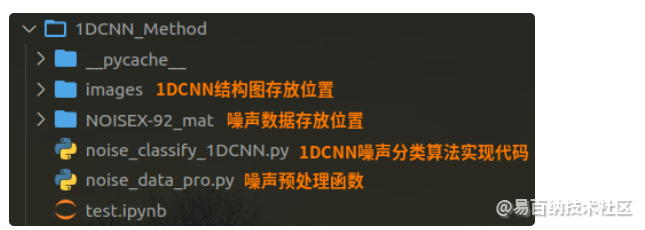技术专栏
Python人工智能:使用Keras库实现基于1维卷积神经网络的噪声分类算法
本文实现基于1DCNN的10种不同噪声类型的分类算法,精度高达99%。本文的操作系统为Ubuntu 22.04,大部分内容与Windows系统相同,唯一不同的文件路径的表示方式不同。
一、噪声数据的获取与预处理
1.1 噪声数据集的获取
- (1) 本文使用SPIB开源噪声数据集NoiseX-92中的15种噪声数据进行基于神经网络的噪声分类算法,官方下载下载地址为:Signal Processing Information Base (SPIB),下载的时候需要一个个下载且下载速度比较慢。
- (2) 也可以通过百度网盘下载
链接: https://pan.baidu.com/s/1FDZ3tMHyLbDPj275hEiuqQ,提取码: ayrr。
1.2 噪声数据的预处理
使用Python对NoiseX-92噪声数据集进行预处理使用了如下四个python库:
将下面的代码存放到如下图所示的noise_data_pro.py文件中,并将下载的NOISEX-92噪声数据聚集放入到同样的目录下。

噪声数据预处理函数noise_data_pro.py函数主要输入参数与返回值如下所示:
(1) 输入参数:
- length:每个样本的数据长度,本文选取1024;
- number:每种噪声类型的样本个数,本文选取1000,10种噪声类型则共具有10000个样本;
(2) 返回值:
- X_train:训练噪声数据(占总体的60%)
- y_train:训练噪声目标值(占总体的60%)
- X_valid:验证噪声数据(占总体的20%)
- y_valid:验证噪声目标值(占总体的20%)
- X_test:测试噪声数据(占总体的20%)
- y_test:测试噪声目标值(占总体的20%)
噪声数据预处理代码:
from scipy.io import loadmat
from sklearn.preprocessing import StandardScaler, OneHotEncoder
from sklearn.model_selection import train_test_split, StratifiedShuffleSplit
import numpy as np
def noise_data_pro(
length=1024, # 每个样本的信号长度
number=100, # 每种信号的样本数
enc_step=28 # 每次增强时候的步长
):
# 读取噪声数据,并存储在files字典中
files = {}
# 依次读取NOISEX-92_mat文件夹中的.mat格式的噪声数据
# (1) 白噪声数据的获取
white = loadmat('./NOISEX-92_mat/white.mat')
files['white'] = white['white'].ravel()
# (2) 粉噪声数据的获取
pink = loadmat('./NOISEX-92_mat/pink.mat')
files['pink'] = pink['pink'].ravel()
# (3) babble噪声数据的获取
babble = loadmat('./NOISEX-92_mat/babble.mat')
files['babble'] = babble['babble'].ravel()
# (4) factory噪声数据的获取
factory = loadmat('./NOISEX-92_mat/factory1.mat')
files['factory'] = factory['factory1'].ravel()
# (5) volvo噪声数据的获取
volvo = loadmat('./NOISEX-92_mat/volvo.mat')
files['volov'] = volvo['volvo'].ravel()
# (6) leopard噪声数据的获取
leopard = loadmat('./NOISEX-92_mat/leopard.mat')
files['leopard'] = leopard['leopard'].ravel()
# (7) f16噪声数据的获取
f16 = loadmat('./NOISEX-92_mat/f16.mat')
files['f16'] = f16['f16'].ravel()
# (8) buccaneer噪声数据的获取
buccaneer = loadmat('./NOISEX-92_mat/buccaneer1.mat')
files['buccaneer'] = buccaneer['buccaneer1'].ravel()
# (9) machinegun噪声数据的获取
machinegun = loadmat('./NOISEX-92_mat/machinegun.mat')
files['machinegun'] = machinegun['machinegun'].ravel()
# (10) hfchannel噪声数据的获取
hfchannel = loadmat('./NOISEX-92_mat/hfchannel.mat')
files['hfchannel'] = hfchannel['hfchannel'].ravel()
keys = files.keys() # 得到files字典的键值
Train_Samples = {} # 所有训练噪声数据样本的暂存字典
# 使用随机滑动的方法分别将10种噪声切分为number个样本,
# 且每个样本的长度为length,滑动的步长为enc_step。
for i in keys:
slice_data = files[i] # 读取每种噪声数据的序列
all_lenght = len(slice_data) # 获取每种噪声数据的长度
end_index = int(all_lenght) # 获得每种噪声数据的结束位置
samp_train = int(number) # 每个样本的噪声信号长度
Train_sample = [] # 存放每种噪声数据的列表
# 随机滑动获得噪声数据切片
enc_time = length // enc_step
samp_step = 0
for j in range(samp_train):
random_start = np.random.randint(
low=0, high=(end_index - 2*length)
)
label = 0
for h in range(enc_time):
samp_step += 1
random_start += enc_step
sample = slice_data[random_start:random_start+length]
Train_sample.append(sample)
if samp_step == samp_train:
label = 1
break
if label:
break
Train_Samples[i] = Train_sample
x_train = [] # 训练数据
y_train = [] # 训练数据标签
label = 0
# 以0-9来表示10种噪声数据的标签
for i in Train_Samples.keys():
x = Train_Samples[i]
x_train += x
lenx = len(x)
y_train += [label] * lenx
label += 1
# 使用StandardScaler()方法对噪声数据进行正则化处理
# 注意:此时x_train由list格式数据转变为ndarray格式
x_train = StandardScaler().fit_transform(x_train)
# 将y_train列表格式数据也转换为one_hot格式
y_train = np.array(y_train).reshape([-1,1])
Encoder = OneHotEncoder()
Encoder.fit(y_train)
y_train = Encoder.transform(y_train).toarray()
y_train = np.asarray(y_train, dtype=np.int32)
# 下面将数据集划分训练数据集与测试数据集
X_train, X_test_temp, y_train, y_test_temp = train_test_split(
x_train, y_train,
test_size=0.4 # 训练数据集与测试数据集的比例为6:4
)
# 然后使用Stratifiedshuffle方法将测试数据划分为验证数据集与测试数据集
ss = StratifiedShuffleSplit(n_splits=1, test_size=0.5)
for train_index, test_index in ss.split(X_test_temp, y_test_temp):
X_valid, X_test = X_test_temp[train_index], X_test_temp[test_index]
y_valid, y_test = y_test_temp[train_index], y_test_temp[test_index]
# 返回值:
# (1) 训练数据集: X_train, y_train
# (2) 测试数据集: X_test, y_test
# (3) 噪声数据标签:keys
return X_train, y_train, X_valid, y_valid, X_test, y_test, keys- 1
- 2
- 3
- 4
- 5
- 6
- 7
- 8
- 9
- 10
- 11
- 12
- 13
- 14
- 15
- 16
- 17
- 18
- 19
- 20
- 21
- 22
- 23
- 24
- 25
- 26
- 27
- 28
- 29
- 30
- 31
- 32
- 33
- 34
- 35
- 36
- 37
- 38
- 39
- 40
- 41
- 42
- 43
- 44
- 45
- 46
- 47
- 48
- 49
- 50
- 51
- 52
- 53
- 54
- 55
- 56
- 57
- 58
- 59
- 60
- 61
- 62
- 63
- 64
- 65
- 66
- 67
- 68
- 69
- 70
- 71
- 72
- 73
- 74
- 75
- 76
- 77
- 78
- 79
- 80
- 81
- 82
- 83
- 84
- 85
- 86
- 87
- 88
- 89
- 90
- 91
- 92
- 93
- 94
- 95
- 96
- 97
- 98
- 99
- 100
- 101
- 102
- 103
- 104
- 105
- 106
- 107
- 108
- 109
- 110
- 111
- 112
- 113
- 114
- 115
- 116
- 117
- 118
- 119
- 120
- 121
- 122
- 123
- 124
- 125
- 126
- 127
<
二、基于Keras的1维卷积神经网络噪声分类算法实现方法
from keras.layers import Dense, Conv1D, BatchNormalization
from keras.layers import MaxPooling1D, Activation, Flatten, Dropout
from keras.models import Sequential
from keras.utils import plot_model
from keras.regularizers import l2
from noise_data_pro import noise_data_pro
import numpy as np
import time
# 训练超参数
batch_size = 128 # 每次训练的批次
epochs = 15 # 训练的轮数
num_classes = 10 # 噪声类别
length = 1024 # 每个噪声样本的长度
number = 1000 # 每种噪声具有的样本数
mark = time.strftime("%Y%m%d_%H%M", time.localtime())
# 获取预处理后的噪声数据,其中,
# 训练数据集:(x_train, y_train)具有6000组数据;
# 验证数据集:(x_valid, y_valid)具有2000组数据;
# 测试数据集:(x_test, y_test)具有2000组数据。
x_train, y_train, x_valid, y_valid, x_test, y_test, keys = noise_data_pro(
length=1024, number=1000
)
# 对数据集添加第三个轴,使其变成张量形式
x_train = x_train[:,:,np.newaxis]
x_valid = x_valid[:,:,np.newaxis]
x_test = x_test[:,:,np.newaxis]
# 下面获取每次送入1DCNN的数据形状
input_shape = x_train.shape[1:]
# 定义一个带有运行时间的模型结构图名的变量model_name
model_name = "cnn_diagnosis-{}".format(mark)
# 实例化一个Sequential
model = Sequential()
# 下面定义1DCNN的结构
# (1) 第一层卷积
model.add(
Conv1D(
filters=16, # 1维卷积核数量
kernel_size=64, # 1维卷积核长度
strides=16, # 卷积核步长
padding='same', # 填充方法
kernel_regularizer=l2(1e-4),
input_shape=input_shape
)
) # 1D卷积层
model.add(BatchNormalization()) # 正则化层
model.add(Activation('relu')) # 激活函数
model.add(MaxPooling1D(pool_size=2)) # 池化层
# (2) 第二层卷积
model.add(
Conv1D(
filters=32,
kernel_size=3,
strides=1,
padding='same',
kernel_regularizer=l2(1e-4),
input_shape=input_shape
)
)
model.add(BatchNormalization())
model.add(Activation('relu'))
model.add(MaxPooling1D(
pool_size=2, strides=2, padding='valid'
))
# (3) 全连接层
model.add(Flatten()) # 展平
model.add(Dropout(0.2)) # 丢弃其中20%的权重,以防止过拟合
model.add(Dense(32)) # 添加全连接层
model.add(Activation('relu')) # 激活函数
# (4) 输出层
model.add(
Dense(
units=num_classes, # 噪声输出类型
activation='softmax', # 输出层激活函数
kernel_regularizer=l2(1e-4)
)
)
# 编译模型
model.compile(
optimizer='Adam', # 优化其
loss='categorical_crossentropy', # 损失函数
metrics=['accuracy'] # 算法衡量指标
)
# 模型训练
model.fit(
x=x_train, y=y_train,
batch_size=batch_size,
epochs=epochs,
verbose=1,
validation_data=(x_valid, y_valid),
shuffle=True
)
# 输出模型结构图
plot_model(
model=model, # 模型
to_file='images/cnn-diagnosis.png', # 存储的位置及其名称
show_shapes=True, # 显示数据形状
show_layer_names=True # 显示每层的名字
)
# 模型评估
score = model.evaluate(x=x_test, y=y_test, verbose=0)
print("测试集上的损失率:", score[0])
print("测试集上的准确率:", score[1])
- 1
- 2
- 3
- 4
- 5
- 6
- 7
- 8
- 9
- 10
- 11
- 12
- 13
- 14
- 15
- 16
- 17
- 18
- 19
- 20
- 21
- 22
- 23
- 24
- 25
- 26
- 27
- 28
- 29
- 30
- 31
- 32
- 33
- 34
- 35
- 36
- 37
- 38
- 39
- 40
- 41
- 42
- 43
- 44
- 45
- 46
- 47
- 48
- 49
- 50
- 51
- 52
- 53
- 54
- 55
- 56
- 57
- 58
- 59
- 60
- 61
- 62
- 63
- 64
- 65
- 66
- 67
- 68
- 69
- 70
- 71
- 72
- 73
- 74
- 75
- 76
- 77
- 78
- 79
- 80
- 81
- 82
- 83
- 84
- 85
- 86
- 87
- 88
- 89
- 90
- 91
- 92
- 93
- 94
- 95
- 96
- 97
- 98
- 99
- 100
- 101
- 102
- 103
- 104
- 105
- 106
- 107
- 108
- 109
- 110
- 111
- 112
- 113
- 114
- 115
<
代码执行结果如下图所示:

预测精度为99.15。
声明:本文内容由易百纳平台入驻作者撰写,文章观点仅代表作者本人,不代表易百纳立场。如有内容侵权或者其他问题,请联系本站进行删除。
红包
点赞
收藏
评论
打赏
- 分享
- 举报
评论
0个
手气红包
 暂无数据
暂无数据相关专栏
-
浏览量:757次2023-09-27 15:33:27
-
浏览量:5073次2021-07-26 11:28:05
-
浏览量:4350次2021-04-19 14:54:23
-
浏览量:880次2024-02-01 14:28:23
-
浏览量:141次2023-08-31 08:46:00
-
浏览量:670次2023-09-02 09:45:20
-
浏览量:393次2023-07-14 14:21:54
-
浏览量:1292次2023-05-13 21:35:31
-
浏览量:5379次2021-05-21 17:03:03
-
浏览量:4039次2018-02-14 10:30:11
-
浏览量:775次2023-06-08 10:35:09
-
浏览量:628次2023-07-18 13:41:23
-
浏览量:6298次2021-06-07 11:48:50
-
浏览量:877次2023-07-05 10:11:45
-
浏览量:639次2023-07-05 10:11:51
-
浏览量:267次2023-07-25 11:57:50
-
浏览量:872次2023-03-21 10:37:02
-
浏览量:104次2023-08-30 20:18:28
-
浏览量:123次2023-08-23 08:46:26
置顶时间设置
结束时间
删除原因
-
广告/SPAM
-
恶意灌水
-
违规内容
-
文不对题
-
重复发帖
打赏作者
Uncle
您的支持将鼓励我继续创作!
打赏金额:
¥1

¥5

¥10

¥50

¥100

支付方式:
 微信支付
微信支付
举报反馈
举报类型
- 内容涉黄/赌/毒
- 内容侵权/抄袭
- 政治相关
- 涉嫌广告
- 侮辱谩骂
- 其他
详细说明
审核成功
发布时间设置
发布时间:
请选择发布时间设置
是否关联周任务-专栏模块
审核失败
失败原因
请选择失败原因
备注
请输入备注



 微信扫码分享
微信扫码分享 QQ好友
QQ好友





